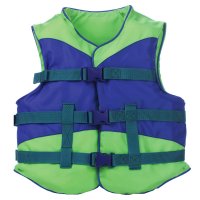While you’re diving and doing cannon balls this summer, your baby can be maxin’ and relaxin’ on the shallow end of the pool, with a drop-top float device. This summer, childrens’ water brands are getting cooler and really stepping up their game with a selection that will bring a smile to your baby’s face and a peace of mind to yours.
Life is made for living and it’s great to expose your baby to new experiences, such as their first interaction to the pool. It can be a hurdle introducing a child into the water environment, but will be an easy task once they catch a glimpse of their water-borne vessel. With floating devices ranging from a simple tubed shape, to whale and duck shaped devices, it will be hard to keep your baby in your arms once they lay eyes on their new transportation. Lather your baby with some great sunblock and grab a floatie with a detachable canopy. Floaties with the canopy attachment offer extra protection from the sun and also keep your baby cool while in the water. Boredom rarely happens with babies, especially in a pool setting, but if this did occur, most of these floaties have toys attached; such as rattles, noisemakers, and steering wheels. With cool shapes of their favorite water animals, you won’t hear any cries or fusses from your little one.
Money is not an issue with these floatation options because you can find them priced from $5.99 to $59.99; keep them for years to come, or even regift when your baby grows! Assembly is easy and most of the floaties just require to be inflated; so easy, a baby can do it! Availability is crucial, which makes these a convenient buy since they can be found at nearly every super store and online.
Although there are many floaties that are kid-safe, don’t forget to bundle the little one in a vest - sure to keep them above water at all times. When it comes to life vests, selecting the right one for your child is very important. It is crucial to determine the best type and make sure, depending on your baby’s age, that they fit correctly and that the vest is safe for them to wear.
When choosing a life vest, make sure that the U.S. Coast Guard approved label is present. This signifies that the vest has been through several safety tests and has passed requirements, therefore ensuring the safety of the vest. Next, buy a size that fits your child appropriately. You want the vest to fit snug, not allowing the chin and ears to slip through. If they do slip through, then the vest is not safe for your child. Kids grow at surprising rates, so do not opt to save money and buy a larger vest they will grow in to. Invest in your child’s safety and get the appropriate size.
There are several vests that give head support for younger children, which is very important; if your baby is younger, make sure the vest has this functionality. Lastly, make sure the vest has a strap at the bottom to clip them into. This prevents the vest from rising above the child’s head which adds further protection.
Due to babies’ proportions when they are younger, it is not completely safe and effective to have a child under 6 months old or 16 pounds to be in a life vest, and therefore, be in the water. Wait until your child is age/weight appropriate to be on the safe side.
Tips!
Never cut or alter a floatation device!
Check the vest and floatation device prior to any water interaction for cuts, rust, mildew, etc. If it doesn’t look safe, it probably isn’t.
Be an example! Children often mimic their parent’s actions, therefore, wear your own life vest so they feel like you are cautious as well.
Do not think that your child does not need a life vest if they have a floatation device or tube. They need to wear a vest at all times until they are fully comfortable in the water and their skills have been tested.

No comments:
Post a Comment